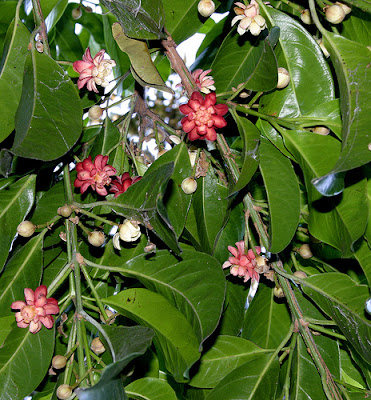Ribbonwood, the lucky survivor
On your way to the Tropical Centre from the Morshead Fountain Gate, opposite the library, you pass a rare and scientifically intriguing tree on your right. It's from Queensland, but well north of the terrible floods causing havoc in the south-east of that State.
The Ribbonwood, or Idiospermum australiense, is not a species you’ll see in many gardens around the Sydney, or indeed the world.
And it is a lonely species – the sole member of a plant genus with very few close relatives alive today. It has large leaves in pairs, and very pretty flowers that start red and turn white, like miniature magnolia flowers.
Forty years ago, we thought the species was extinct. Our Volunteer Guides tell the story of how in 1971, four cows in the Daintree area died mysteriously. The farmer ordered an autopsy and several large seeds of the Ribbonwood were found in their stomachs.
This was the first time the species had been sighted – albeit in a slightly obscure location – for 70 years. Only discovered in 1902, its habitat was cleared for sugar cane growing in the 1920s.
Like the Wollemi Pine, it’s thought this species is little changed from trees that grew at the time of the dinasaurs, over 100 million years ago. The rediscovery in 1971 led to it being re-examined and classified, resulting in it getting its own genus and at the time its own family name (Idiospermaceae).
Its distinctiveness, particularly its fleshy fruits and numerous seed leaves (cotyledons), has been supported by further research and recent DNA analysis, but it now nestles in a more widespread family.
The Botanic Gardens Trust got hold of some seed in 1973 and we now have this graceful tree producing lots of small but attractive flowers every autumn.
The previous Director of Missouri Botanical Garden in St Louis, USA, Dr Peter Raven, was keen to get some seed so they could grow this species for research into the origins of flowering plants. So far we haven’t had any seed produced and we assume it needs cross fertilisation between plants.
In 1997 another specimen was planted in the newly created Rare and Threatened Garden over the other side of the Royal Botanic Gardens. When both plants are in flower we’ll do what an insect would do in the wild, and carry pollen from one plant to the other, hopefully leading to seed set.
Image: A lovely photo of the plant growing in Sydney's Royal Botanic Gardens, taken by Tony Rodd, and available for non-commercial use from FlickRiver. *This posting is from the Radio Archives (May 2008).
The Ribbonwood, or Idiospermum australiense, is not a species you’ll see in many gardens around the Sydney, or indeed the world.
And it is a lonely species – the sole member of a plant genus with very few close relatives alive today. It has large leaves in pairs, and very pretty flowers that start red and turn white, like miniature magnolia flowers.
Forty years ago, we thought the species was extinct. Our Volunteer Guides tell the story of how in 1971, four cows in the Daintree area died mysteriously. The farmer ordered an autopsy and several large seeds of the Ribbonwood were found in their stomachs.
This was the first time the species had been sighted – albeit in a slightly obscure location – for 70 years. Only discovered in 1902, its habitat was cleared for sugar cane growing in the 1920s.
Like the Wollemi Pine, it’s thought this species is little changed from trees that grew at the time of the dinasaurs, over 100 million years ago. The rediscovery in 1971 led to it being re-examined and classified, resulting in it getting its own genus and at the time its own family name (Idiospermaceae).
Its distinctiveness, particularly its fleshy fruits and numerous seed leaves (cotyledons), has been supported by further research and recent DNA analysis, but it now nestles in a more widespread family.
The Botanic Gardens Trust got hold of some seed in 1973 and we now have this graceful tree producing lots of small but attractive flowers every autumn.
The previous Director of Missouri Botanical Garden in St Louis, USA, Dr Peter Raven, was keen to get some seed so they could grow this species for research into the origins of flowering plants. So far we haven’t had any seed produced and we assume it needs cross fertilisation between plants.
In 1997 another specimen was planted in the newly created Rare and Threatened Garden over the other side of the Royal Botanic Gardens. When both plants are in flower we’ll do what an insect would do in the wild, and carry pollen from one plant to the other, hopefully leading to seed set.
Image: A lovely photo of the plant growing in Sydney's Royal Botanic Gardens, taken by Tony Rodd, and available for non-commercial use from FlickRiver. *This posting is from the Radio Archives (May 2008).

Comments